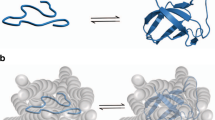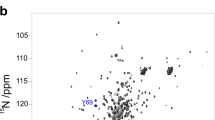Abstract
The interactions of biological macromolecules with water are fundamental to their structure, dynamics and function. Historically, characterization of the location and residence times of hydration waters of proteins in solution has been quite difficult. Confining proteins within the nanoscale interior of a reverse micelle slows water dynamics, allowing global protein-water interactions to be detected using nuclear magnetic resonance techniques. Complications that normally arise from hydrogen exchange and long-range dipolar coupling are overcome by the nature of the reverse micelle medium. Characterization of the hydration of ubiquitin demonstrates that encapsulation within a reverse micelle allows detection of dozens of hydration waters. Comparison of nuclear Overhauser effects obtained in the laboratory and rotating frames indicate a considerable range of hydration water dynamics is present on the protein surface. In addition, an unprecedented clustering of different hydration-dynamics classes of sites is evident.
This is a preview of subscription content, access via your institution
Access options
Subscribe to this journal
Receive 12 print issues and online access
$189.00 per year
only $15.75 per issue
Buy this article
- Purchase on Springer Link
- Instant access to full article PDF
Prices may be subject to local taxes which are calculated during checkout




Similar content being viewed by others
References
Ball, P. Water as an active constituent in cell biology. Chem. Rev. 108, 74–108 (2008).
Otting, G., Liepinsh, E. & Wuthrich, K. Protein hydration in aqueous solution. Science 254, 974–980 (1991).
Otting, G. NMR studies of water bound to biological molecules. Prog. Nucl. Magn. Reson. Spectrosc. 31, 259–285 (1997).
Bagchi, B. Water dynamics in the hydration layer around proteins and micelles. Chem. Rev. 105, 3197–3219 (2005).
Halle, B. Protein hydration dynamics in solution: a critical survey. Philos. Trans. R. Soc. Lond. B Biol. Sci. 359, 1207–1224 (2004).
Pal, S.K. & Zewail, A.H. Dynamics of water in biological recognition. Chem. Rev. 104, 2099–2124 (2004).
Zaccai, G. The effect of water on protein dynamics. Phil. Trans. R. Soc. Lond. B 359, 1269–1275 (2004).
Mattea, C., Qvist, J. & Halle, B. Dynamics at the protein-water interface from O-17 spin relaxation in deeply supercooled solutions. Biophys. J. 95, 2951–2963 (2008).
Gruschus, J.M. & Ferretti, J.A. Quantitative measurement of water diffusion lifetimes at a protein/DNA interface by NMR. J. Biomol. NMR 20, 111–126 (2001).
Halle, B. Cross-relaxation between macromolecular and solvent spins: The role of long-range dipole couplings. J. Chem. Phys. 119, 12372–12385 (2003).
Frezzato, D., Rastrelli, F. & Bagno, A. Nuclear spin relaxation driven by intermolecular dipolar interactions: the role of solute-solvent pair correlations in the modeling of spectral density functions. J. Phys. Chem. B 110, 5676–5689 (2006).
Jeener, J., Vlassenbroek, A. & Broekaert, P. Unified derivation of the dipolar field and relaxation terms in the Bloch-Redfield equations of liquid NMR. J. Chem. Phys. 103, 1309–1332 (1995).
Modig, K., Liepinsh, E., Otting, G. & Halle, B. Dynamics of protein and peptide hydration. J. Am. Chem. Soc. 126, 102–114 (2004).
Babu, C.R., Flynn, P.F. & Wand, A.J. Validation of protein structure from preparations of encapsulated proteins dissolved in low viscosity fluids. J. Am. Chem. Soc. 123, 2691–2692 (2001).
Valentine, K.G. et al. Magnetic susceptibility-induced alignment of proteins in reverse micelles. J. Am. Chem. Soc. 128, 15930–15931 (2006).
Wand, A.J., Ehrhardt, M.R. & Flynn, P.F. High-resolution NMR of encapsulated proteins dissolved in low-viscosity fluids. Proc. Natl. Acad. Sci. USA 95, 15299–15302 (1998).
Peterson, R.W., Lefebvre, B.G. & Wand, A.J. High-resolution NMR studies of encapsulated proteins in liquid ethane. J. Am. Chem. Soc. 127, 10176–10177 (2005).
Thompson, K.F. & Gierasch, L.M. Conformation of a peptide solubilizate in a reversed micelle water pool. J. Am. Chem. Soc. 106, 3648–3652 (1984).
Babu, C.R., Hilser, V.J. & Wand, A.J. Direct access to the cooperative substructure of protein and the protein ensemble via cold denaturation. Nat. Struct. Mol. Biol. 11, 352–357 (2004).
Peterson, R.W., Anbalagan, K., Tommos, C. & Wand, A.J. Forced folding and structural analysis of metastable proteins. J. Am. Chem. Soc. 126, 9498–9499 (2004).
Kielec, J.M., Valentine, K.G., Babu, C.R. & Wand, A.J. Reverse micelles in integral membrane protein structural biology by solution NMR spectroscopy. Structure 17, 345–351 (2009).
Workman, H. & Flynn, P.F. Stabilization of RNA oligomers through reverse micelle encapsulation. J. Am. Chem. Soc. 131, 3806–3807 (2009).
Valentine, K.G. et al. Reverse micelle encapsulation of membrane-anchored proteins for solution NMR studies. Structure 18, 9–16 (2010).
Piletic, I.R., Moilanen, D.E., Spry, D.B., Levinger, N.E. & Fayer, M.D. Testing the core/shell model of nanoconfined water in reverse micelles using linear and nonlinear IR spectroscopy. J. Phys. Chem. A 110, 4985–4999 (2006).
Park, S., Moilanen, D.E. & Fayer, M.D. Water dynamics—The effects of ions and nanoconfinement. J. Phys. Chem. B 112, 5279–5290 (2008).
Fenn, E.E., Wong, D.B. & Fayer, M.D. Water dynamics at neutral and ionic interfaces. Proc. Natl. Acad. Sci. USA 106, 15243–15248 (2009).
Vijay-Kumar, S., Bugg, C.E. & Cook, W.J. Structure of ubiquitin refined at 1.8 A resolution. J. Mol. Biol. 194, 531–544 (1987).
Hershko, A. & Ciechanover, A. The ubiquitin system. Annu. Rev. Biochem. 67, 425–479 (1998).
Marion, D., Kay, L.E., Sparks, S.W., Torchia, D.A. & Bax, A. 3-dimensional heteronuclear NMR of 15N-labeled proteins. J. Am. Chem. Soc. 111, 1515–1517 (1989).
Clore, G.M., Bax, A., Wingfield, P.T. & Gronenborn, A.M. Identification and localization of bound internal water in the solution structure of interleukin 1 beta by heteronuclear three-dimensional 1H rotating-frame Overhauser 15N–1H multiple quantum coherence NMR spectroscopy. Biochemistry 29, 5671–5676 (1990).
Brüschweiler, R. & Wright, P.E. Water self-diffusion model for protein-water NMR cross relaxation. Chem. Phys. Lett. 229, 75–81 (1994).
Nakasako, M. Water-protein interactions from high-resolution protein crystallography. Phil. Trans. R. Soc. Lond. B 359, 1191–1206 (2004).
Alexeev, D. et al. Synthetic, structural and biological studies of the ubiquitin system: chemically synthesized and native ubiquitin fold into identical three-dimensional structures. Biochem. J. 299, 159–163 (1994).
Persson, E. & Halle, B. Nanosecond to microsecond protein dynamics probed by magnetic relaxation dispersion of buried water molecules. J. Am. Chem. Soc. 130, 1774–1787 (2008).
Ernst, J.A., Clubb, R.T., Zhou, H.X., Gronenborn, A.M. & Clore, G.M. Demonstration of positionally disordered water within a protein hydrophobic cavity by NMR. Science 267, 1813–1817 (1995).
Zhou, H.-X., Rivas, G. & Minton, A.P. Macromolecular crowding and confinement: Biochemical, biophysical, and potential physiological consequences. Annu. Rev. Biophys. 37, 375–397 (2008).
Mukherjee, S., Chowdhury, P. & Gai, F. Tuning the cooperativity of the helix-coil transition by aqueous reverse micelles. J. Phys. Chem. B 110, 11615–11619 (2006).
Simorellis, A.K. & Flynn, P.F. Fast local backbone dynamics of encapsulated ubiquitin. J. Am. Chem. Soc. 128, 9580–9581 (2006).
DeLano, W.L. The PyMOL Molecular Graphics System (DeLano Scientific LLC, Palo Alto, California, USA, 2009).
Wand, A.J., Urbauer, J.L., McEvoy, R.P. & Bieber, R.J. Internal dynamics of human ubiquitin revealed by 13C-relaxation studies of randomly fractionally labeled protein. Biochemistry 35, 6116–6125 (1996).
Baryshnikova, O.K., Williams, T.C. & Sykes, B.D. Internal pH indicators for biomolecular NMR. J. Biomol. NMR 41, 5–7 (2008).
Palmer, A.G. III, Cavanagh, J., Wright, P.E. & Rance, M. Sensitivity improvement in proton-detected two-dimensional heteronuclear correlation NMR spectroscopy. J. Magn. Reson. 93, 151–170 (1991).
Zuiderweg, E.R.P. & Fesik, S.W. Heteronuclear 3-dimensional NMR spectroscopy of the inflammatory protein C5A. Biochemistry 28, 2387–2391 (1989).
Bax, A., Ikura, M., Kay, L.E., Torchia, D.A. & Tschudin, R. Comparison of different modes of 2-dimensional reverse-correlation NMR for the study of proteins. J. Magn. Reson. 86, 304–318 (1990).
Norwood, T.J., Boyd, J., Heritage, J.E., Soffe, N. & Campbell, I.D. Comparison of techniques for 1H-detected heteronuclear 1H-15N spectroscopy. J. Magn. Reson. 87, 488–501 (1990).
Bax, A. & Davis, D.G. Practical aspects of two-dimensional transverse NOE spectroscopy. J. Magn. Reson. 63, 207–213 (1985).
Bothner-By, A.A., Stephens, R.L., Lee, J., Warren, C.D. & Jeanloz, R.W. Structure determination of a tetrasaccharide: transient nuclear Overhauser effects in the rotating frame. J. Am. Chem. Soc. 106, 811–813 (1984).
Griesinger, C. & Ernst, R.R. Frequency offset effects and their elimination in NMR rotating-frame cross-relaxation spectroscopy. J. Magn. Reson. 75, 261–271 (1987).
Goddard, T.D. & Kneller, D.G. SPARKY 3.0. (University of California, San Francisco, San Francisco, California, USA).
Macura, S. & Ernst, R.R. Elucidation of cross relaxation in liquids by two-dimensional NMR spectroscopy. Mol. Phys. 41, 95–117 (1980).
Farrow, N.A. et al. Backbone dynamics of a free and a phosphopeptide-complexed Src homology 2 domain studied by 15N NMR relaxation. Biochemistry 33, 5984–6003 (1994).
Kay, L.E., Nicholson, L.K., Delaglio, F., Bax, A. & Torchia, D.A. Pulse sequences for removal of the effects of cross correlation between dipolar and chemical-shift anisotropy relaxation mechanisms on the measurement of heteronuclear T1 and T2 values in proteins. J. Magn. Reson. 97, 359–375 (1992).
Peng, J.W. & Wagner, G. Mapping of spectral density functions using heteronuclear NMR relaxation measurements. J. Magn. Reson. 98, 308–332 (1992).
Coleman, R.G. & Sharp, K.A. Travel depth, a new shape descriptor for macromolecules: application to ligand binding. J. Mol. Biol. 362, 441–458 (2006).
Coleman, R.G. & Sharp, K.A. Shape and evolution of thermostable protein structure. Proteins 78, 420–433 (2010).
Connolly, M.L. Analytical molecular surface calculation. J. Appl. Cryst. 16, 548–558 (1983).
Lee, B. & Richards, F.M. The interpretation of protein structures: estimation of static accessibility. J. Mol. Biol. 55, 379–400 (1971).
Acknowledgements
We are grateful to K. Valentine, J. Gledhill and J. Dogan for helpful discussion and to B. Halle for comments on an early draft of this manuscript. Supported by a grant from the US National Science Foundation (MCB-0842814) and a grant from the Mathers Foundation. N.V.N. is the recipient of a US National Institutes of Health postdoctoral fellowship (GM 087099).
Author information
Authors and Affiliations
Contributions
A.J.W. designed and initiated the study. M.S.P. carried out preliminary NMR experiments. N.V.N. optimized the NMR experiments, and collected and analyzed the data. A.J.W. and N.V.N. wrote the manuscript.
Corresponding author
Ethics declarations
Competing interests
A.J.W. declares a competing financial interest as a member of Daedalus Innovations, LLC, a manufacturer of high pressure and reverse micelle NMR apparatus.
Supplementary information
Supplementary Text and Figures
Supplementary Figures 1–4 and Supplementary Tables 1–2 (PDF 393 kb)
Rights and permissions
About this article
Cite this article
Nucci, N., Pometun, M. & Wand, A. Site-resolved measurement of water-protein interactions by solution NMR. Nat Struct Mol Biol 18, 245–249 (2011). https://doi.org/10.1038/nsmb.1955
Received:
Accepted:
Published:
Issue Date:
DOI: https://doi.org/10.1038/nsmb.1955
This article is cited by
-
Prediction of hydrophilic and hydrophobic hydration structure of protein by neural network optimized using experimental data
Scientific Reports (2023)
-
High-field/High-frequency EPR Spectroscopy in Protein Research: Principles and Examples
Applied Magnetic Resonance (2023)
-
Hyperpolarized water as universal sensitivity booster in biomolecular NMR
Nature Protocols (2022)
-
Protein conformational entropy is not slaved to water
Scientific Reports (2020)
-
Sensitivity-enhanced three-dimensional and carbon-detected two-dimensional NMR of proteins using hyperpolarized water
Journal of Biomolecular NMR (2020)



